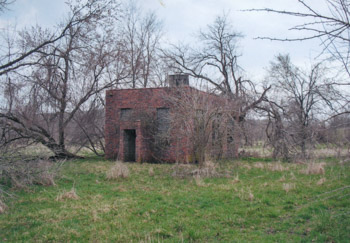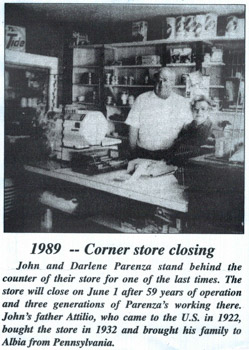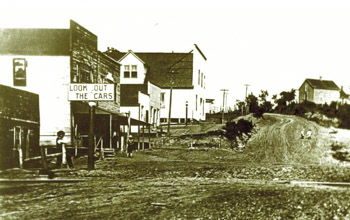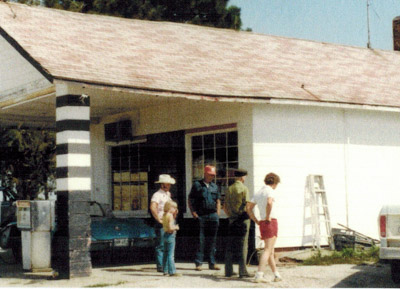
http://www.buxtoniowa.com • Consol, Haydock & Buxton Iowa, USA • 1871 - 2014
Casey’s General Store History | Iowa Coal Mining
Story by Gordon R. Peterson
Casey’s Gas Station General Stores history could well extend back into the 1880s and the coal mining era in Monroe and Mahaska Counties, Iowa. Legend has it that the founder of Casey’s Gas Station General Stores, Donald Lamberti, got his idea for Casey’s while visiting the Parenza store at the Melrose Corners on US Highway 34 between Albia and Chariton, Iowa. For sure, Casey’s history is associated with that Peterson/Parenza Gas Station General Store. The store was built by my grandfather, David Peterson, in 1927 and sold to the Attilio Parenza family in 1932 for $1,200. It was in the Parenza family for nearly 50 years then destroyed to make room for the expansion of the Melrose Corners intersection in 1989.
A fair question is “How could Casey’s chain of over 1,900 gas station/convenience stores possibly have its history dating back to 1880, at least 20 years before gasoline driven cars were a staple in America’s culture?” There was no need for gas stations much before the early 1900s. Then the automobile was developed as our mode of transportation, replacing the horse and buggy.
According to a story in the 1991 fall issue of “The Iowan”, the Casey’s Gas Station General Store was started in 1959 after the founder had visited the then Parenza store at the Melrose Corners on US Highway 34. On a 1970 visit with John Parenza at the store, he told my dad and me the same story. How then, can I try to convince everyone that Casey’s has its history dating back to 1880 in Iowa coal mining camps? Good question! The answer to the question is engrained in the history of the Consolidation Coal Company in Southern Iowa and, in particular, Monroe County.
Monroe County became the largest coal mining county in Iowa in the early 1900’s. The Consolidation Coal Company, the largest coal mining company in the county, was owned by the Chicago and North Western Railroad. It was common for railroad companies to own their own coal mines in order to assure themselves of a reliable source of coal to fire the steam powered locomotives. The BTU’s in coal is much higher than the BTU’s in wood. Coal from Monroe County was known for having high BTU’s, but was high in waste materials (sulfur etc.) A little know fact is that Iowa during the “Coal Dust Era” around the turn of the 20th Century was the fifth largest coal mining state in the nation.
Since coal mines were not, for the most part, located near a town of any size that could provide adequate housing for miners and their families, companies such as the Consolidation Coal Company would build coal mining camps. In some cases these camps were larger in population than 95% of the towns in Iowa at that time. The exception was in Des Moines where many coal mines were located. The companies bought acres of land and built company houses on that land for the miners and their families to rent for $5.00/7.00 per month. The number of houses built were in the thousands. Mining camps grew in size that often exceeded 5,000 inhabitants in population.The houses were moved from camp to camp along with the buildings for businesses, schools and churches!
Many historians don’t consider the coal mining camps to be camps because they had populations that large in number. I, for one, consider them camps because the coal mining camps moved locations every 10-20 years in the manner of a camp and unlike a permanent town. The camps were never incorporated as is typical with towns. The image of a coal mining camp with a population of 5,000 habitants paints a more vivid picture than an image of a town.
The Consolidation Coal Company moved its coal mining camps three times in less than 50 years. Those coal camps were broken into approximately three periods of time:
1880 - 1900 Muchakinock coal fields, mines 1-9
1900 - 1914 Buxton coal field, mines 10-17
1914 - 1930 Consol coal field, mines 18-19 and 20
(shaft sank,but the mine 20 was never opened)
The Consolidation Coal Company closed its coal mining activities in Iowa when it closed mines number 18 and 19 in 1927. It was at that time that the connection to the founding of Casey’s draws its connection. The company closed the mines and deserted the miner houses located in Bucknell and Haydock. Where, upon a Monroe County judge’s order, the vacant houses were sold for a mere $50 per home. Apparently there were back taxes owned to Monroe County by the railroad company. These houses were as solid as brick homes and many had survived moves from the Muchakinock camp to the Buxton camp in the early 1900’s and then starting in 1914 to the Bucknell, Haydock and Mine 18 camps in the Consol coal fields.
After the Consolidation Coal Company left Monroe County in 1927, my grandparents, rather than move from Monroe County like most of the miners did, decided to remain in the county with their eight children. It was at that time that they purchased four of the deserted miner’s houses in Haydock in order to build the original Casey’s style gas station/convenient store at the Melrose Corners location on U.S. Highway 34, six miles directly south of their Haydock home.
The Parenza store was built by my grandfather from lumber from homes that at one time may have been located in the Muchakinock mining camp as far back as 1880. When the founder of Casey’s got the idea for his company from visiting the Parenza store at the Melrose Corners, it was lumber from the deserted miners’ houses that was used by my grandfather to built the Parenza gas station general store. Grandpa’s brother, Oscar, actually did the construction of the building. Oscar later owned a furniture store in Chariton.
The government decided in 1982 to destroy the store. The Parenza family hated to see what had been their home for 50 years destroyed for a simple widening of a highway intersection. There was an abundance of land to the north of the intersection that could have accommodated the expansion. John Parenza called my dad, Ray Peterson, at our home in Charles City, Iowa to inquire about when the store had been built. Apparently if the store had been built prior to 1923 it qualified as some type of historical site and the Parenzas could challenge the government destroying their home. However, Dad admitted the store was built in 1927 based on the timing of the closing of the mines and the fact that Grandpa had used a brand new 1927 Chevy truck to transport the lumber from the abandoned Haydock miners’ homes to the Melrose Corners location.
I often have thought if Dad only had relayed to John Parenza the complete history of the Parenza store and its connection to the founding of the Casey’s Gas Station General Stores, just maybe the original Casey’s in concept would still be pumping gas at the Melrose Corners intersection. Quite frankly, I never did understand what age has to do with the historical significance of a building.
The story of my Grandpa Peterson being the “Casey” of his generation parallels the history of the Consolidation Coal Company in Monroe County, Iowa. The Consolidation Coal Company mines were initially located near Given,Iowa between Oskaloosa and Eddyville, Iowa. It was formed in 1874 by the McNeill Bros. and J.E. Graves. The Chicago & North Western Railroad purchased the Consolidation Coal Company from the original owners in 1881. They labeled the mining operation the Muchakinock coal fields and the mining camp simply, “Muchakinock.” Company coal mines 1-9 were operated out of the Muchakinock coal mining camp. In 1900, the company developed the Buxton coal mining fields in Monroe County for their mines 10-17. The coal mines in the Muchakinock coal field were becoming depleted.
In 1903, Grandpa Peterson and his brother John had immigrated to Buxton from Ransater, Sweden in order to seek employment as coal miners. Their brother, Oscar, was already a coal miner in Buxton. With no experience as a miner, Grandpa suffered the fate of so many miners when he was severely injured after slate fell on him in the mine causing him to be crippled. Fortunately for Grandpa, a grocer near where my Grandparents lived in Buxton’s East Swede Town by the name of J.E. Larsen hired him to work in his store. Grandpa would scoot around in a non-motorized cart to fill orders that were then delivered to customers throughout Buxton.
Grandpa went through rehabilitation for his injuries and was then able to walk, but with a cane. He then partnered with Albert Hagglund and opened a Cooperstown grocery store in the same building as the B.F. Coopers Pharmacy. Mr. Cooper was colored. They ran that store until 1916 when fire destroyed that store, as well as most of the Buxton suburb of Cooperstown, located just north of Buxton proper in Mahaska County. Coincidentally, at the time of the Cooperstown fire, the coal company was developing the Consol mining fields with mine number 18. The Consol coal mining fields were located 20 to 25 miles to the southwest of the Buxton coal mining fields, but still in Monroe County.
With the Buxton coal mining fields being depleted, Grandpa leased a building for a store from the Falvey Lumber Company in the Consol mining camp, rather than rebuilding in the Buxton coal mining fields. He remained in the Consol store from 1916 to1922. In the front of the Grandpa’s Consol store was the Consol Post Office where Grandpa was the Post Master.
In 1922, optimism was running high in the Consol mining fields. Grandpa in 1922 built a new brick home with an adjacent store in the Midway area between Haydock and Bucknell. Since coal mining camps often relocated, brick was seldom used for buildings, especially miners homes. To my knowledge, the Peterson home was the only brick home to be built in any coal mining camp.
It was in a prime location, at the intersection of the north-south Melrose Road(527th Avenue) and the main east-west road connecting Haydock and Bucknell(160thStreet). The idea for building a home of brick, I am sure spawned from the fact Grandmother’s Cousins, Ted and Ed Sampson, built the Consol Movie House prior using brick. The home also had an unique feature of a Delco electric generator in the basement. The brick walls of the home’s ruins are still standing as are the brick walls of the Sampson Movie House ruins in the Consol mining camp. The brick wall ruins in Consol and Haydock are the about the only remaining evidence there ever were coal mining camps of 3,000/4,000 miners and their families in the area.
In 1923, Coal Company announced its intention of sinking mine 20 over 200 feet deep in Haydock and moving its corporate headquarters to the area near mine 20. Mine 20 was located less than one mile west from where Whites Creek passes under the Melrose Road (527th Avenue) and just 1/4 mile north of Whites Creek. About that time, the Consolidation Coal Company changed its name to the Superior Coal Company, but it was still owned by the Chicago and North Western Railroad.
In early 1927, the Company was about to open the newly sunk Mine 20, but instead the company abruptly ceased its Iowa operation totally and moved its coal mining operations to Gillespie, Illinois, 40 miles north of St. Louis. The lives of thousands of miners, including my Grandparents, changed dramatically. Miners moved from the coal mining camps to Iowa’s larger industrial cities of Waterloo, Des Moines, Cedar Rapids, Sioux City and Davenport in the style of those in John Steinbeck’s “Grapes of Wrath” book. My dad told me of watching coal miners and their families driving past the Haydock Peterson store with all their belongings in a truck as they left the Consol coal fields of Monroe County.
I had an occasion when exploring with current Bucknell resident Terry Williams in the backwoods of Haydock, near the Bucknell High School location,to find a steel bed frame still sitting on a cement house foundation that was left by a miner when he and his family left Haydock nearly 100 years ago! Terry and his wife Sue have a home along 160th Street in what was know as the Bucknell’s Bottom Camp.
With the majority of coal miners leaving the coal fields, my Grandparents’ future looked grim in the coal fields as well. However, rather than abandoning their home in the Consol coal fields, my Grandparents remained in their Haydock brick home that they had built only a few years prior. The ruins of the brick walls are still standing at the intersection of County Road 38 (160th Street) and the Melrose road (527th Ave.). When I was a tyke, in the early 1940’s, I slept in the home whose ruins are now but four standing brick walls. My Grandma, Emma Peterson, operated the Haydock store, a wooden structure, that sat immediately adjacent to the north of the brick home.
After the Superior Coal Company closed it’s mines, with Grandpa’s experience as a store owner and operator, he decided to build a gas station/ convenience store six miles directly south of the Haydock store at the Melrose Corners on the newly paved US Highway 34. With lumber from deserted Haydock coal miners’ homes, Grandpa built a Casey’s style “Super” gas station general store that included groceries, a bar, and a car repair garage to be run by my Dad, Dad had gained experience as a mechanic working for Kitterman’s auto repair garages in Albia and Haydock. Grandpa sold the Melrose Corners store to the Parenza family in 1932.
After selling the Melrose Corners store to the Parenza family, Grandpa later opened a gas station in Georgetown, 5 miles to the east of the Parenza Melrose corners store on U.S. Hwy. 34. The gas station was located across the road to the west from the Georgetown Catholic Church and school. For a car repair ramp in order to work under a car, Grandpa would drive the car part-way up the side of the ditch of Highway 34 that ran in front of the gas station.
All of the Peterson children,with the exception of their youngest, Roy, completed their schooling at the Bucknell High School. The school closed in 1935. Roy continued his schooling at the Georgetown Catholic School and lived with his Dad in the living quarters to the rear of the Georgetown gas station. Grandma continued to live in Haydock, a distance of 7 miles from Georgetown, and operated the Haydock store. Roy later continued his high school education in Des Moines and Charles City, where he graduated in 1941. Grandpa left the Georgetown gas station in 1941 and he and Grandma moved to California during WW2.
During the WW2 years, my Grandparents, Dave and Emma Peterson, lived and worked in the shipyards of Richmond, California near Oakland/ San Francisco. After the war ended in 1945, they returned to where else, but Buxton’s East Swede Town to farm the very land that once was the Buxton coal mining camp. Initially when they moved back to Buxton, they lived in the Johnson house that was located where Scotty Schippers home is now located. They purchased the Bloom home in 1947. The Bloom house is now the home of Mark and Lisa Keeton.
When Grandpa and Grandma both died in the late 1950s, Grandma had lived 72 of her 76 years on the land of coal mining camps of southern Iowa and the Consolidation Coal Company, including Buxton’s East Swede town (30 years), Muchakinock (14 years), Consol (8 years), and Haydock (20 years).To trace my grandma’s life history in the coal mining camps of southern Iowa is to trace the history of the Consolidation Coal Company in Monroe and Mahaska Counties in Iowa.
I first walked “hand in hand” with Grandpa and Grandma in the early 1940s, exploring the old deserted coal mining camps of Monroe County. To this day, 75 years later, I am still walking “hand in hand” with them when I continue to explore my families history in the deserted coal mining camps of Monroe County, Iowa. What a joyous walk it has been for over 70 years. The gas station general store concept that Grandpa pioneered at the Melrose Corners location in 1927 after the Consolidation Coal Company closed it’s mines continues to thrive. “Casey’s” now has over 1,900 stores throughout the midwest. It seems like every street corner in America now has a Gas Station General Store.
Whenever I now stop at a Casey’s General Store for gas or a snack, especially pizza, I recall my families history in Gas Station General Stores. Instead of Casey’s, I call the stores, D.A’s, after my Grandfather, David Alexis Peterson, also known as simply, D.A.
The Iowan, Fall 1991
Still Pumping Gas After All These Years
By Mike Whye
A 1960s gas guzzler, sporting competing patches of rust and brown primer paint over its once-red body, speeds west from Albia on U.S. 34. Waves of heat rippling above the pavement make the car shimmer like a low-flying airplane. Near Melrose, the driver, in his later teens and wearing a trace of an unshaven beard, turns the car off the road near a brown-painted wood building that clearly is several decades older than his vehicle. “Parenza Store - Gas Food Beer” read the signs atop the peaked roof that extends over the two gas pumps. The boy pulls his car up to the front door.
Standing behind the counter in the gas station, John Parenza sees the young man walk through the doorway and immediately reaches to a shelf for a can of tomato soup. “Hi ya Bob,” he calls to the teen, tossing him the can. “I’m sure this is what your mom is going to want tonight.”
“Sure is. Thanks,” replies the teen, snatching the can out of the air with the sure swiftness of a pro baseball player. With a nod at the few people sitting in the Spartan brown booths along one wall, he turns and exits the room. A moment later the sounds of his snarling engine and spinning wheels announce his departure, bound westward for home.
Through a nearby window, Parenza watches the car fade down the highway until it’s pulled apart and then swallowed by the heat waves. Mentally, Parenza notes the quarters he’ll add to the family’s account. Like the owners of all small gas stations, if there’s one thing John Parenza knows, he knows his customers.
Walking out from behind the counter, Parenza joins his wife, Darlene, and a couple of friends at one of the four booths. There may have been a fifth booth once, but the middle space is now filled by an upright cooler emblazoned with red-and-white Coke signs across its top and sides. Compared to the warmth of the wood in the booths, floor, wall, and cabinets, the plastic, glass, and metal cooler is a cold-hearted monster. its sterile fluorescent light spills out across the floor.
“This station was built in 1927 and it’s been added to again and again over the years. My father bought it in 1932 and I got it in 1962,” Parenza tells a visitor. This breed of gas station is rare nowadays. Although an air conditioner hums heavily, pumping cool air into the building, the place is warm and welcoming. Family pictures spot the wall behind the booths. A back door shows the way to the house where John and Darlene raised nine children.
“My father had his children help run the place, and I had my children help too,” says Parenza, who has lived his life in the house. “It’s always been a family business. We didn’t have hired help. It used to be busier, but the operations are down to where Ma and me can handle it now.”
Parenza’s station was affiliated with Standard Oil Company for 30 years before turning independent 29 years ago. “We’re open from seven in the morning ’til seven-thirty, nine-thirty at night - however late if someone needs something…” comments Parenza. His many years in the gas business have given Parenza some colorful stories to tell, including one about a supplier who visited the store every so often not all that many years ago and occasionally asked how Parenza was making a go of it, selling fuel and food.
“I felt like he was picking my brain when he visited, but I’m sure he saw more when he was traveling on the road elsewhere. He told me once that he saw a need in rural areas for gas stations that were like a country store. I guess he like what he saw because he opened up his own store a short time later. In Ames, I think,” Parenza says. “After that he opened up some others and began making a chain of them with another fellow. Have you ever seen Casey’s when you travel across the Midwest? That’s what that guy started.”
John Parenza laughs as he tells the story.
- That was last year, In early June of this year (1991), Parenza closed his store forever. Another of the original gas stations is gone. -Article reprinted with permission.

























